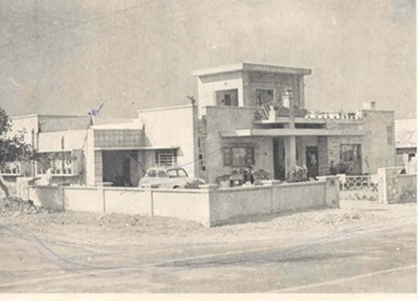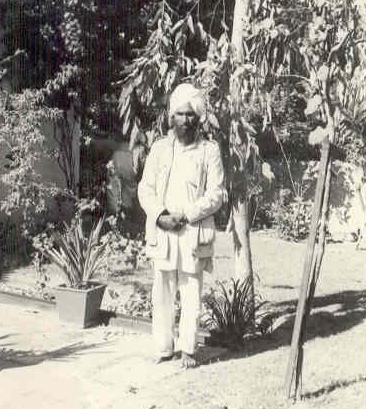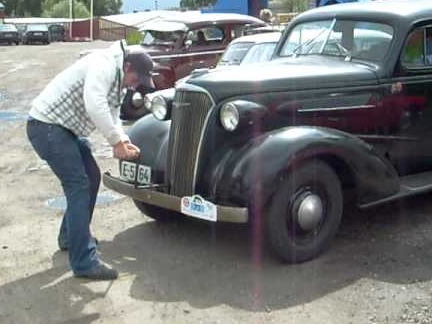Our Family Hillman MInx RJZ 2

Subhash Mathur was born and brought up in small towns in Rajasthan. During his school and college education at Jaipur, he was keenly involved in sports, journalism and public speaking. His civil services career has given him a platform for spreading his ideas about modernising tax administration to benefit the common man. Post retirement he is devoting his energies, along with his wife Tilak, to public and humane causes.
Family Car Hillman
In 1969, I had the privilege of driving Morarji Desai, who later became India’s Prime Minister, in our beloved family car:the Hillman.In a manner of speaking it was an iconic moment in my life. I have written a detailed account of driving Morarji Desai in Hillman in“My meetings with the Prime Minister when he was out of power”onwww.indiaofthepast.org.
In the 1960s/70s owning a car was prestige itself. As most cars were owned by the rich and powerful they were usually driven by drivers, better own as chauffeurs. Most of the chauffeurs were liveried too, white or navy blue.

Those days employment meant lifetime service with that particular family. They usually becameall-rounders and were often dubbed as Man Friday. There was lot of pride in being associated with rich or powerful families. These chauffeurs spent better part of the day and evening with the family. Other family members of Man Friday also got employment with the family as a gardener or a chowkidar or dog caretakers and so on.
Our family car at the time was a two-toned Hillman Minx, a British origin middle-sized family car. The roof was dark blue and the body was light blue. It was luxurious when compared to similar sized modern Indian cars. It had large sofa like seats,cushy and comfortable.
Daddy bought the car second hand in Bikaner but it was registered in Ajmer, where he was posted as Collector and District Magistrate from September 1957 to July 1958.
In those days, license plate numbers consisted of three parts. The first and second letters RJ indicated Rajasthan, the state in which the vehicle was registered. The next part consisted of a letter that identified the district. Since Ajmer was the last district to join Rajasthan, it was designated Z. The third and last part consisted of a number unique to each engine and chassis. Thus our Hillman had RJZ 2 license plate.
The Commissioner of Ajmer Division was in charge of a few Districts that formed the Division. Each district was headed a by Collector and District Magistrate. The Commissioner Ajmer Division got the the licence plate RJZ 1 for his car. Daddy, who was Collector Ajmer, got RJZ 2. The number plate did not change later. The special number "2" always signified that the car was special and got priority passageway in Ajmer.
When Daddy was posted to Jaipur, we moved into a house called Jawala Bhawan in C-Scheme. The Hillman used to be parked in the garage whose entry was from the side street. The narrow garage was built into the house. The entrance was very narrow and cramped.
But parking the car was easy. Once parked, only the driver side door could be operated. While the car was parked, it was a bit boxed in but in those days no one complained about these minor inconveniences.
But reversing the car out of the narrow garage needed a different skill set. There was no room for an error of even one inch. The car had to come out on the street as straight as possible. The path had to be ramrod straight or else the passenger side doors would touch the wall.
I started driving the Hillman from my school days in 1963-64. I got the driver’s license in 1966. My brothers and I learnt to drive the car from the family chauffer and Man Friday Sadiq mian. As my younger brother Subodh remembers it, when Sadiq mian was teaching, he would caution us to drive slowly and carefully and mutter:
भैय्याजी, जल्दीकाकामशैतानका”.

Meaning “speed is the work of the devil.” He believed in getting to the destination safe and sound – no rushing! Subodh related this story to his own son, Abhijai, when he was teaching him how to drive.
He would often admonish me for driving too fast . but roads in those days were hardly congested in the C – Scheme area.
Sadiq mian continued to be associated with our family years after his retirement. even his son Samshad often dropped in to help the family in heavy lifting.
Sadiq mian, Daddy’s driver, standing in our garden at B-87, Ganesh Marg, Jaipur. 1960s.
The Hillman ran very smoothly in its initial years.The ride felt as if one were in a Cadillac, a favourite of Indian royalty and the wealthy. It even had side indicators. When one touched the indicator switch, a narrow plastic arm would pop out. When the car had completed the turn, magically the indicator arm would return to its fold. And it was all mechanical.
As the years wore on,the car started failing in various ways. The Hillman could be purring like a cat one moment and get stalled the next. The car had a peculiar carburettor issue which was the culprit for stalling the running car or not restarting easily. But once in motion it provided a very cool driving and seating experience
The problem of carburettor was linked with the petrol tank which was slung too low. And car needed a full tank to operate efficiently. Since we hardly ever tanked up fully, the mechanical pump was not able to throw up clean petrol up the system. It always carried some slush which often choked the carburettor.
Experts opined that the petrol in those days was of an inferior quality with lot of undesirable sediments. The stalling etc. was related to the combination of all these factors.
This called for engagement of special skill sets. In those days, all four wheelers came equipped with handles. If the starter failed then the handle had to be pushed in a slot in the engine and cranked vigorously. The handle would be worked in a fast consistent circular motion.One had to stand on one side and crank because sometimes the handle would recoil and jump out and hit the person.

The cranking was always a very strenuous exercise. And one felt quite exhausted after repeated cranking to bring the engine to life.
Hindi movies from the 1950/60s used to show the villain using the handle as an offensive weapon. The new cars have completely dispensed with this system. The technology has improved vastly since then. Recall the stranded Ambassador cars on the road due to overheating of the engine.
Our Hillman was of course made of sterner stuff. The Hillman would not start even with vigorous cranking. How could it with a choked carburettor, so the rescue operation went like this:
Keep the driver side door open. Then, keep the bonnet open. Push the handle in the slot. Take the carburettor cover off. With your left hand, pull taut the starter wire (located next to carburettor) while also keeping part of your hand over the carburettor to suck up the petrol.
But just enough petrol!(If lots of petrol came through, the overflow would choke the engine.) Then with right hand, turn the handle round as fast and as vigorously as possible. If the engine fired, pull and release the starter wire to rev and ebb the engine.
To ensure the petrol flow.
Then let your fast moving skill came into play. Run and move into the driver's seat and press the accelerator. Once the engine was purring, come out of the car, replace the carburettor cover, pull down the bonnet, remove the handle and drive away.
It helped if a companion was with you during the ride. Preferably a male as in those days one could hardly ask the ladies to fiddle with carburettors or crank the handle.
The Hillman also came equipped with a two stage 'chor' gear: the reverse gear could be engaged only when the driver pulleda gear knob mounted on the right side of the steering. Simultaneously the left hand pushed the gear stick down swiftly in the reverse mode.
Only a gifted few were able to master this art of science!
A few years ago I noticed a similar reverse gear arrangement but much more sophisticated in car Sail which I test drove.
But, at times, the Hillman would not simply respond to all our tricks. Then we had to abandon the car on the road. We would simply push the car with help of passersby to one side of the road and it was taken as parked. Many road users recognised the car and smiled wryly.
But our ‘parked’ car was never pilfered ever. Frankly, there was nothing to pilfer in the first place.
Later on a mechanic would bring the car home.
Although the Hillman gave us trouble often times, the family was reluctant to part with it. At least family owned a car and they simply adored the car.
Hence ina moment of bravadomy youngest brother Satish declared that ‘if one could drive the Hillman, then one could drive any car anywhere in the world’.
I would imagine skills ingrained in the 1970s - 1980s on Hillman stood Satish in good stead while driving through the national parks of Canada in the mid-2000s.
My wife, Tilak, and I have some happy memories of our courtship days associated with the Hillman.
Finally, the car was sold by its weight and for several years the family possessed no car. We used Tongas, rickshaws or bicycles for our commutes. Or even walk.
We miss the car.
Even today.
Add new comment